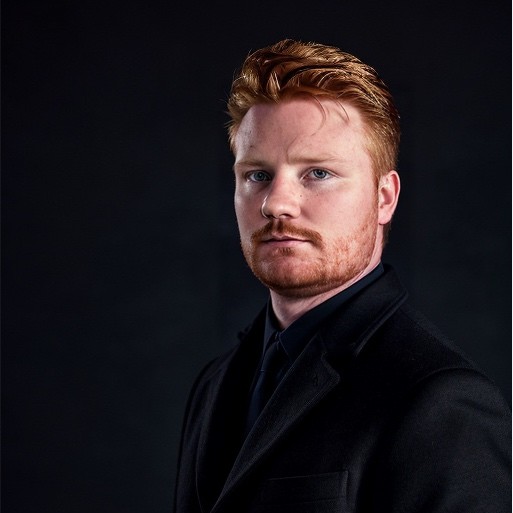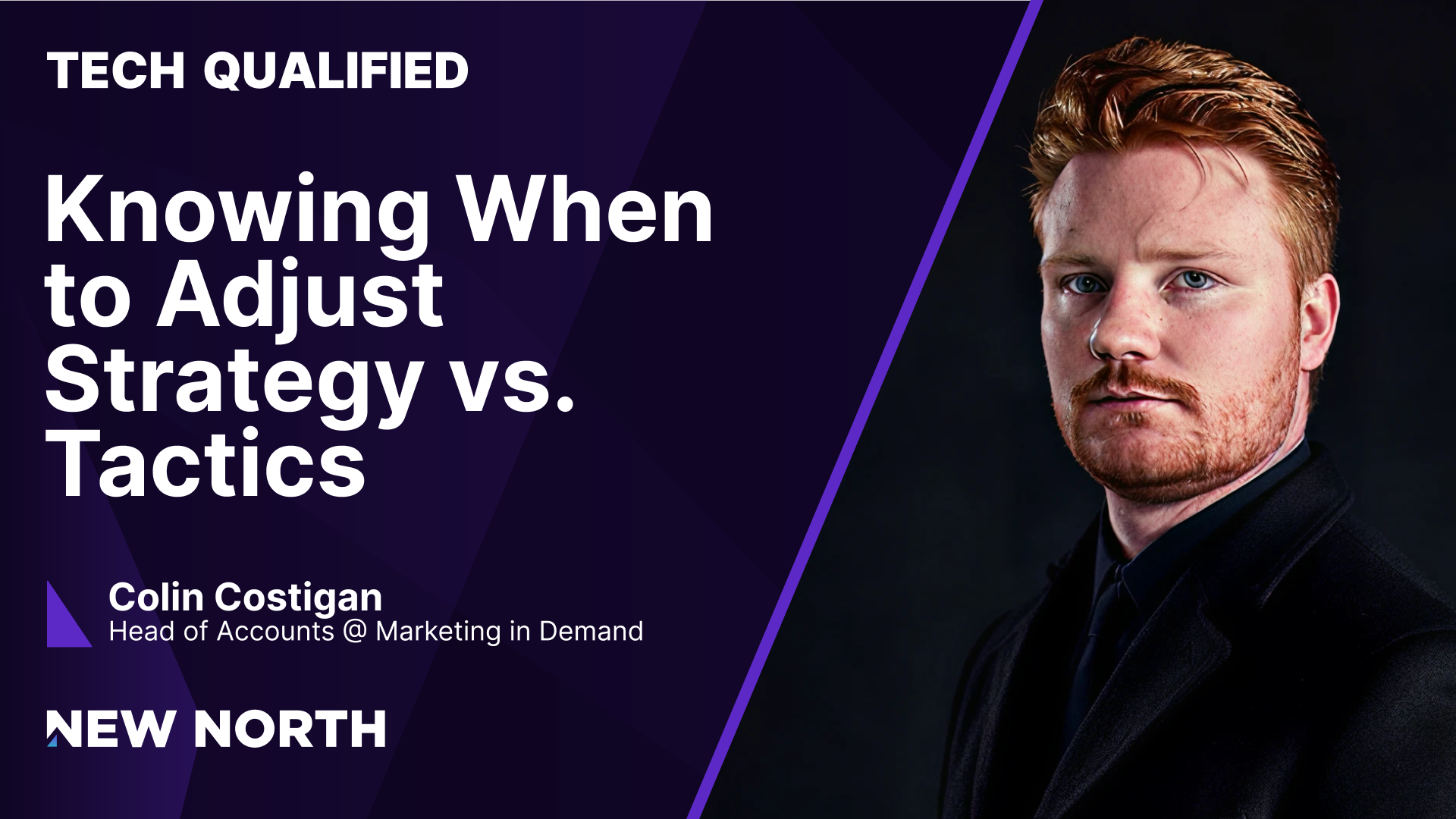Episode Summary
Marketers often jump directly into tactics, feeling pressure to show progress. In this episode of Tech Qualified, Baylee Gunnell and Colin Costigan, Head of Accounts at Marketers in Demand, discuss how to build a stronger marketing foundation. Colin explains that the desire for tangible results and leadership pressure cause teams to skip essential planning.
A strong marketing plan starts with a business goal. This “North Star” guides your strategy, which defines who you will target. Only then should you develop tactics like email outreach or social media ads. Every tactic must trace back to the strategy and serve the main business outcome.
Knowing when to adapt is critical. Colin explains how to tell if a problem is tactical or strategic. Signals like a low click-through rate may require a tactical change. However, major issues like a doubling cost-per-lead signal a need to revisit your strategy. This framework helps teams stay structured while remaining flexible.

Colin Costigan
Head of Accounts
Noteworthy: An advocate for iterative marketing who champions progress over perfection.

Key Insights
Why Marketing Teams Prioritize Motion Over Mission
Marketing teams often rush into tactics, like launching a new ad or email sequence, before establishing a clear strategy. This “tactic-first” approach stems from two common pressures: deadlines and the desire for tangible proof of progress. Leadership often wants results immediately, creating a sense of urgency. In response, teams launch campaigns because activity feels like achievement. It is easier to show a screenshot of a new ad than a picture of a messaging framework. This focus on visible motion provides a false sense of security. However, this momentum is often misguided without a solid strategy to direct it. Taking the time to align on goals and strategy first ensures that every action serves the company’s ultimate mission.
The G-S-T Framework: Connecting Goals, Strategy, and Tactics
A successful marketing plan follows a clear hierarchy: Goals, then Strategy, then Tactics. The process must start at the top with a clear business outcome. For example, a goal could be generating $2 million in qualified pipeline from a specific market segment by a certain quarter. This goal is the “North Star” for the entire company. The next step is strategy, which answers who you need to talk to and what channels they use. This could mean targeting growth leaders with insight-led content. Only then do you move to tactics, such as creating email sequences, running social media ads, or testing calls to action. Every tactic, from a single ad to a CRM entry, must directly support the strategy and trace back to the main business goal.
Red Lights on the Dashboard: When to Pivot Your Marketing Strategy
Knowing when to adjust tactics versus overhauling your entire strategy is crucial for efficient marketing. Several “red lights” indicate a need for a strategic shift, not just a minor tactical tweak. For example, if your cost per lead doubles for weeks and your customer acquisition cost continues to grow without a corresponding increase in pipeline, you have a structural problem. This requires a move back to the drawing board. Other strategic alarms include market shifts, such as a new, well-funded competitor entering the space or new regulations changing buyer priorities. When these major signals appear, you must pause and ask if your core strategy—the destination for your customer’s journey—is still correct, or if you need to change the route entirely.
Tactical Wobble vs. Strategic Misdirection: Diagnosing Your Problems
All marketing problems are not created equal. To fix them, you must first diagnose whether the issue is tactical or strategic. Signals can help you identify the root cause. If you see low click-through rates or a stagnant pipeline, the problem may be strategic; you could be talking to the wrong audience. This requires rebuilding your targeting list. In contrast, if you get ad clicks but no landing page conversions, the problem is likely tactical. The value proposition may be unclear or the offer may not be strong enough. This calls for a tactical switch, like rewriting headlines. A useful analogy is to think of your strategy as the compass and tactics as the wheels. If the compass is off, you must recalibrate. If the wheels wobble, you just need to tighten the bolts.
Episode Highlights
The Foundation of Marketing: Data, Intent, and Mission
Timestamp: [00:00:00]
The episode opens by defining the relationship between core marketing elements. Colin establishes that effective marketing balances data (what is happening) and intent (what you want to happen). Goals provide the foundation and keep the team grounded in the mission. Strategy provides the guiding path toward those goals. Tactics are the flexible actions taken—the “sails” adjusted based on shifting winds (data). The key is constantly ensuring that the tactics (what you are doing) serve the overarching mission (the goal). This fundamental understanding prevents teams from executing tasks that do not drive the business forward.
“Great marketing is a conversation between data and intent. Goals will keep us grounded. Strategy will guide us. But the tactics are gonna be the ways that we adjust the sails, based on the ways that the wind is shifting.”
Safeguarding Strategy Before Execution
Timestamp: [00:02:00]
Marketers often default to what is visible (tactics) unless the whole organization celebrates the roadmap (strategy) as much as the output. To prevent this, Colin emphasizes the importance of a structured kickoff process. Before discussing creative assets or specific messaging, the outcome of the campaign and the Ideal Customer Profile (ICP) must be crystal clear. If the team cannot align on the desired outcome and the target audience, the conversation about tactical execution must be delayed. This safeguard ensures that strategy remains the priority, preventing misalignment before the work begins and resources are spent.
“The way that I try to safeguard that with clients is when I have a kickoff deck that I’m putting together, the first two slides in that kickoff deck are outlining what is the outcome of this campaign or strategy that we’re putting together, and who are we talking to?”
Balancing Structure and Flexibility: Fixed vs. Fluid Marketing
Timestamp: [00:07:15]
Marketers face the challenge of adapting to change without wasting money or losing data capture. Colin suggests dividing marketing plans into “fixed” and “fluid” components. Fixed elements include core goals, revenue targets, and the North Star KPI. These only change if leadership shifts the company’s focus. Fluid elements are the tactics. This includes testing new channels, adjusting the channel mix, trying new creative angles, or splitting budgets between different ad platforms (like LinkedIn vs. Google). The strategy (fixed) provides structure and defines what you are trying to achieve. The tactics (fluid) allow for flexibility, optimizing the approach.
“The things that are fluid are those tactics. Do we need to try a new channel? Do we need to try a new mix of channels and combine how we’re messaging and making sure that we’re hitting people in the right time when they’re there?”
The Rigidity Spectrum: Timeframes for Goals, Strategy, and Tactics
Timestamp: [00:09:11]
Goals, strategy, and tactics operate on different timeframes. Goals should remain fixed for longer periods, typically six months to a year. Strategy falls in the middle; it is rigid but flexible. You might realize a strategy is not working after one to six months, requiring a return to the drawing board based on data. Tactics, however, should change constantly based on incoming data. Colin warns against putting all your resources into a single successful tactic. Even if a channel is performing well (“performing like crazy”), you must constantly test new approaches to avoid relying on a single point of failure.
“I would say your goals should stay fixed for a little bit longer over a period. You should probably have those for six months to a year, but your strategy is gonna be kind of rigid, but also kind of flexible. It falls somewhere in the middle. Tactics should be changing all the time based on the data that is coming in.”
